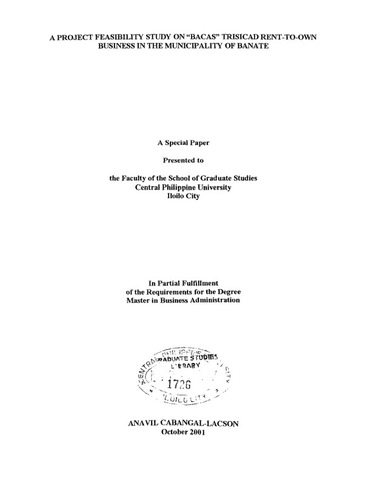A feasibility study on "BACAS" trisikad rent-to-own business in the Municipality of Banate

Page views
1,759Petsa
2001May-akda
Tagapangulo ng Panel ng Depensa
Magbahagi
Metadata
Ipakita ang buong tala ng item
Abstract
Last 1997 an association was organized by a group of Banatenhons who happened not only to be neighbors, friends, and family members. The association was called “Banate Community Association”, (BACAS) an Ilonggo term, which means “strive”.
Like most organizations, associations, and even foundations, “BACAS” keeps track of the events (not only) in the municipality and is active in the activities that promote the socio-economic and political environment of the town. In its operation, it directly or indirectly supports the further growth of the town through the administration’s unrelenting vigilance for progressive, creative, productive and peaceful community. Its principal aim is to provide livelihood and employment to a big number of Banatenhons. The association has thought of an easy and practical business which can be managed by the association members and the residents of the community. The association during their first quarter meeting for the year 2000 decided to put up a “trisicad-rent-to-own” business. The target renters/owners are those who are unemployed and/or self-employed, most particularly those “estambays” (idle). These people are always look upon by the community as adversaries and threat to society. The “BACAS” members have observed, that the ‘trisicad” is considered as one of the major transports within the town proper and to and from nearby barangays. The members of “BACAS”, further noted that this means of transport is very affordable to the majority and can be supportive of the nation’s campaign to “save gas and energy” and “pollution free environment”.
In putting up a trisicad business, some of the factors to be considered are : materials needed, the plant and garage, equipment and tools, safety controls and operations and the personnel and the renters/owners.
Materials Needed
The materials needed are: a single bike and side car. The bike may be purchased assembled or unassembled. The side car on the other hand, can be personally assembled by the “BACAS” members or this can be contracted out to a person who assembles sidecars.
Plant and Garage
The plant and garage will be under the control of the association. The managing officer, shall prepare and recommend the necessary plans , indicating the specific activity or additional work to be conducted in the garage, expected not hazardous and a nuisance to neighboring residents. The plant and garage structures shall be big enough to provide sufficient space for the “trisicads”, sanitary and safety operations.
Equipment and Tools
All equipment and tools shall be installed and maintained properly to facilitate the assembly, cleaning and repair and maintenance of the “trisicad” units.
Safety Controls and Operations
The renter/operators shall have adequate knowledge about safety controls and measures in the day-to-day operations of the “trisicads”. The maintenance personnel must inspect the units prior to their dispatch. The renter/owner must be encouraged to make an honest report of the condition of the units he handles. Parts needed for the repair and replacement shall be monitored and as much as possible, must be available all the time.
Personnel
The management shall take measures regarding against accidents. There should be provision for cleanliness, training and supervision of “trisicad” driver/renter-owner. Responsibility for assuring compliance by all renter/owner, personnel and members of the association with all the requirements shall be clearly assigned to a competent supervisor and member/personnel of “BACAS”.
Objectives of the Problem
This feasibility study seeks to determine the profitability and viability of the “TRISICAD-RENT-TO-OWN” business in Banate.
Specifically, this study will seek to answer the following questions:
1. Marketing Aspect
a. Does the “trisicad” have a strong demand in the town?
b. In terms of quality and durability, is the design appropriate to the user’s needs?
c. How much will a ride cost?
d. Who are the prospective customers and users.
2. Management Aspect
a. Who are the persons responsible for the management of the association’s project?
b. What are the qualifications needed for the member and renter/owner to be admitted or considered by the association?
c. What is the ideal rate of compensation if ever for member-employees of the association?
d. What are the techniques that can be adapted in order to avoid breach of contract in the flow of the proposed project?
3. Technical Aspect
a. What are the materials needed for the assembly of a “trisicad” unit?
b. What tools and equipment are used in assembling “trisicads”?
c. Where is the possible location of the project’s plant and garage?
4. Financial Aspect
a. How much capitalization is needed to start the business?
b. How much is the expected income to be earned after the first year of operation?
c. How long will it take to recover the investment?
5. Socio-Economic Aspect
a. How can the business help the economy of the town?
b. Will the riders have enough funds to pay for their fares?
Paglalarawan
Introduction and statement of the problem
Mungkahing Sipi
Lacson, A. C. (2001). A feasibility study on "BACAS" trisikad rent-to-own business in the Municipality of Banate (Unpublished Master’s special paper). Central Philippine University, Jaro, Iloilo City.
Uri
Special paperMga keyword
Kagawaran
School of Graduate StudiesDegree
Master in Business AdministrationLokasyon ng Istante
GSL Theses 650.072 L119
Pisikal na paglalarawan
75 leaves

